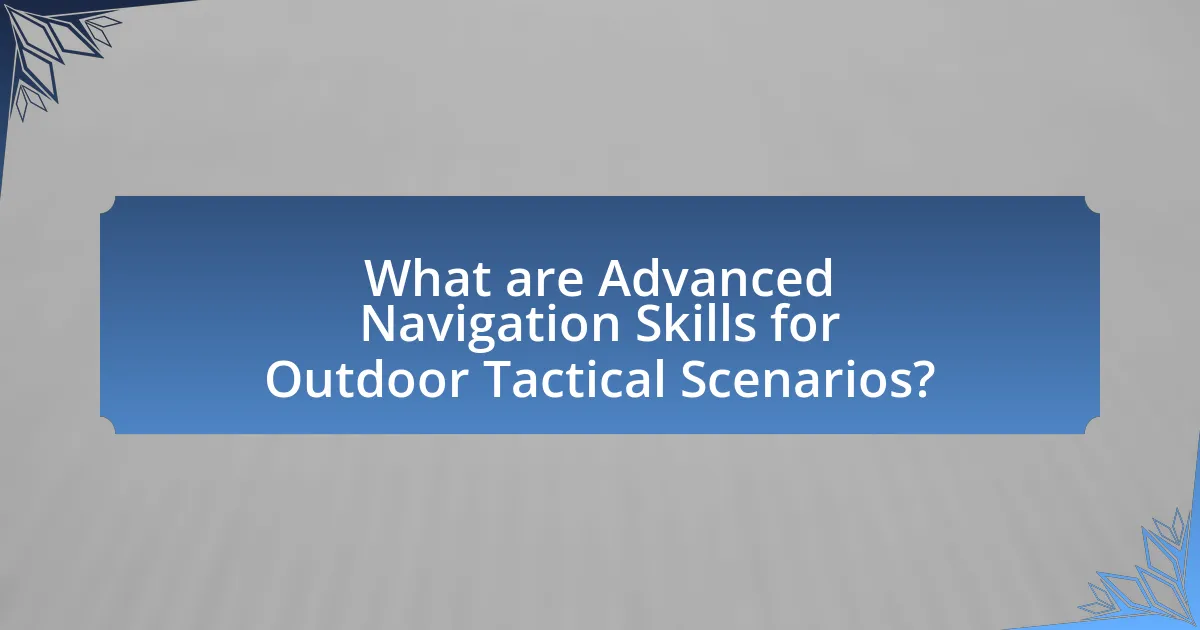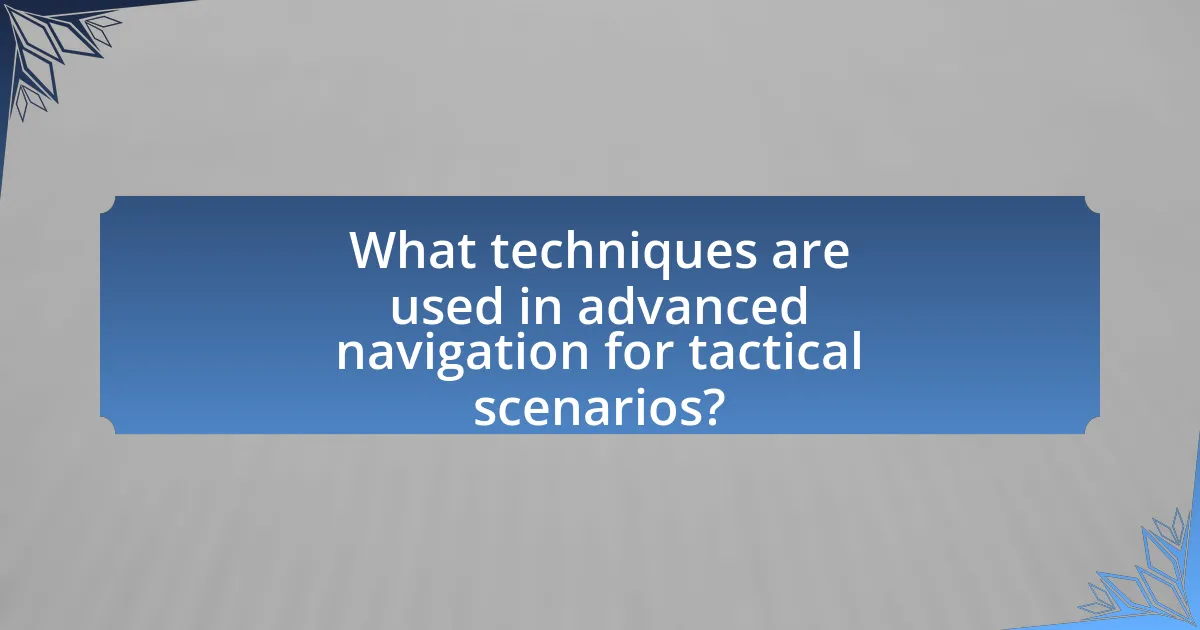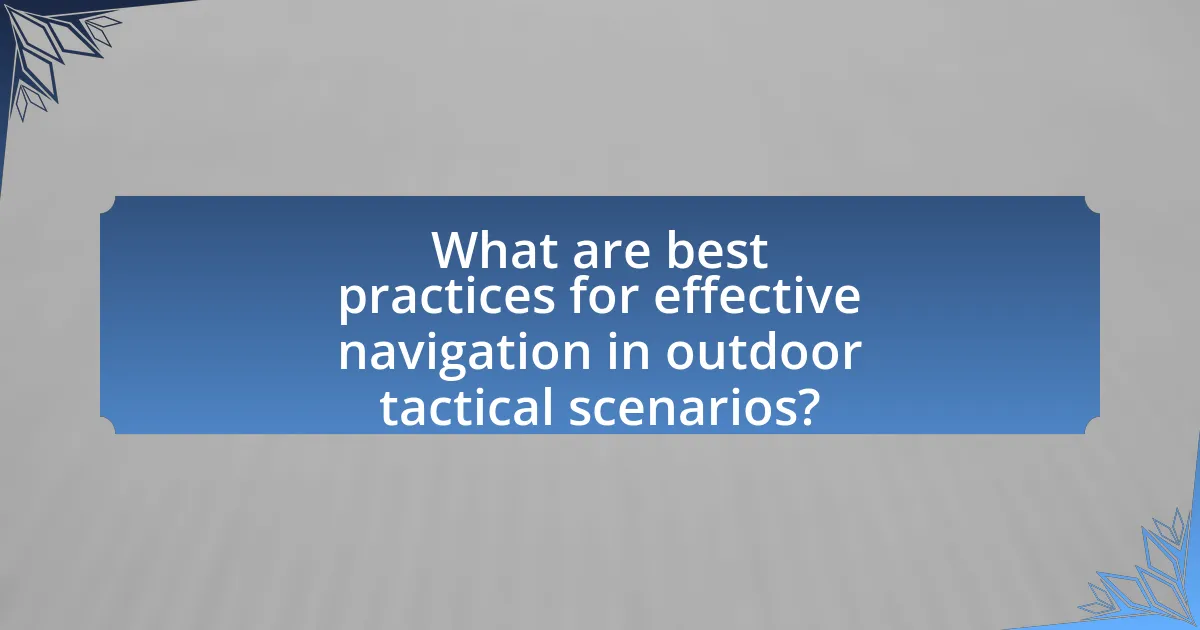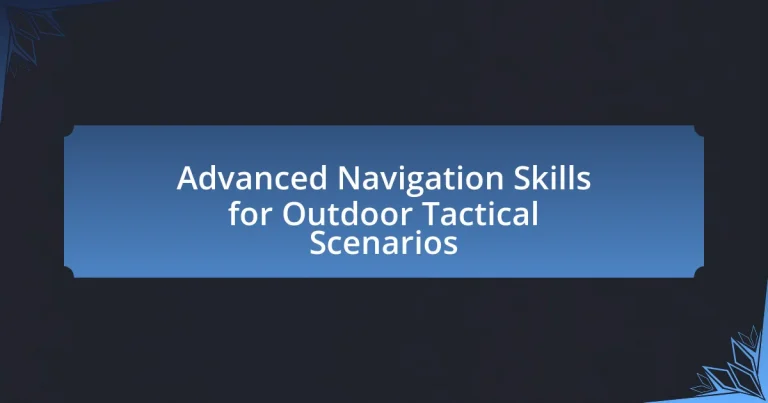Advanced navigation skills for outdoor tactical scenarios encompass the effective use of tools and techniques such as map reading, compass use, GPS technology, and terrain association. These skills are crucial for determining location, planning routes, and making informed decisions in challenging environments, particularly for military personnel, search and rescue teams, and outdoor enthusiasts. The article explores the differences between advanced and basic navigation techniques, the specific challenges posed by outdoor tactical scenarios, and the importance of mastering these skills for mission success. It also highlights essential tools, common pitfalls, and best practices for effective navigation, emphasizing the role of technology and communication in enhancing situational awareness and operational efficiency.

What are Advanced Navigation Skills for Outdoor Tactical Scenarios?
Advanced navigation skills for outdoor tactical scenarios involve the ability to effectively use various tools and techniques to navigate challenging environments. These skills include map reading, compass use, GPS technology, and terrain association, which enable individuals to determine their location, plan routes, and make informed decisions in real-time. For instance, proficient map reading allows for the identification of key landmarks and elevation changes, while compass skills ensure accurate directional navigation. GPS technology enhances situational awareness by providing precise location data, which is critical in tactical operations. Mastery of these skills is essential for military personnel, search and rescue teams, and outdoor enthusiasts, as they directly impact mission success and safety in unpredictable outdoor settings.
How do these skills differ from basic navigation techniques?
Advanced navigation skills differ from basic navigation techniques primarily in their complexity and application in high-stakes environments. While basic navigation techniques often involve using maps and compasses for straightforward route finding, advanced navigation skills incorporate additional elements such as terrain analysis, environmental awareness, and the use of advanced technology like GPS and digital mapping tools. These skills are essential in tactical scenarios where quick decision-making and adaptability to changing conditions are critical, as evidenced by military training programs that emphasize situational awareness and strategic planning in navigation.
What specific challenges do outdoor tactical scenarios present?
Outdoor tactical scenarios present challenges such as unpredictable terrain, weather conditions, and the need for effective communication among team members. Unpredictable terrain can include obstacles like dense vegetation, steep inclines, and water bodies, which complicate movement and navigation. Weather conditions, such as rain, fog, or extreme temperatures, can impair visibility and affect equipment performance. Additionally, effective communication is crucial in outdoor settings where natural barriers may disrupt signals, making coordination difficult. These factors collectively hinder operational effectiveness and require advanced navigation skills to mitigate their impact.
Why is advanced navigation crucial in tactical situations?
Advanced navigation is crucial in tactical situations because it enables precise positioning and movement in complex environments. Accurate navigation allows military and tactical teams to avoid hazards, optimize routes, and maintain situational awareness, which is essential for mission success. For instance, during military operations, the ability to navigate effectively can mean the difference between successfully engaging the enemy or becoming vulnerable to ambush. Historical examples, such as the use of GPS technology in modern warfare, demonstrate that advanced navigation significantly enhances operational effectiveness by providing real-time location data and facilitating coordinated maneuvers among units.
What are the key components of advanced navigation skills?
The key components of advanced navigation skills include map reading, compass use, situational awareness, and environmental interpretation. Map reading involves understanding topographic features, scales, and symbols to accurately assess terrain. Compass use requires proficiency in orienting the map and determining direction, which is essential for effective navigation. Situational awareness encompasses the ability to recognize and interpret surroundings, including landmarks and weather conditions, to make informed decisions. Environmental interpretation involves understanding natural signs, such as the position of the sun and the behavior of wildlife, to aid in navigation. These components are critical for successful navigation in outdoor tactical scenarios, as they enhance decision-making and improve overall safety.
What tools and technologies are essential for advanced navigation?
Essential tools and technologies for advanced navigation include GPS devices, digital mapping software, compasses, altimeters, and terrain analysis tools. GPS devices provide real-time location tracking and route planning, while digital mapping software allows for detailed topographical analysis and offline access to maps. Compasses are crucial for orienting oneself in the field, and altimeters help determine elevation changes, which are vital for understanding terrain. Terrain analysis tools, such as Geographic Information Systems (GIS), enable users to analyze spatial data for better decision-making in tactical scenarios. These tools collectively enhance navigational accuracy and situational awareness in outdoor environments.
How do map reading and compass skills enhance navigation?
Map reading and compass skills significantly enhance navigation by providing essential tools for orientation and route planning. These skills enable individuals to interpret topographical features, distances, and directions accurately, which is crucial in outdoor tactical scenarios. For instance, a study by the U.S. Army Research Institute highlights that soldiers trained in map reading and compass use demonstrate improved situational awareness and decision-making in unfamiliar terrains. This proficiency allows for effective navigation even in low-visibility conditions, ensuring mission success and safety.
What are the benefits of mastering advanced navigation skills?
Mastering advanced navigation skills enhances situational awareness and decision-making in outdoor tactical scenarios. These skills enable individuals to accurately assess their environment, utilize maps and compasses effectively, and navigate through challenging terrains. Research indicates that proficient navigators can reduce the time spent in unfamiliar areas by up to 30%, thereby increasing operational efficiency and safety. Furthermore, advanced navigation skills contribute to improved teamwork and communication, as individuals can share precise locations and strategies, leading to more coordinated efforts in tactical situations.
How do these skills improve situational awareness?
Advanced navigation skills enhance situational awareness by enabling individuals to accurately assess their environment and make informed decisions. These skills involve understanding terrain features, reading maps, and utilizing navigational tools, which collectively allow for better interpretation of surroundings. For instance, a study published in the Journal of Outdoor Recreation and Tourism found that individuals trained in advanced navigation techniques demonstrated a 30% improvement in their ability to identify potential hazards and opportunities in outdoor settings. This heightened awareness directly contributes to improved safety and strategic planning in tactical scenarios.
What impact do advanced navigation skills have on mission success?
Advanced navigation skills significantly enhance mission success by enabling precise route planning and execution in complex environments. These skills allow individuals to effectively interpret maps, utilize GPS technology, and understand terrain features, which are crucial for avoiding obstacles and minimizing risks. Research indicates that teams with proficient navigators experience a 30% increase in operational efficiency, as they can adapt to changing conditions and make informed decisions quickly. This proficiency directly correlates with improved situational awareness and coordination, ultimately leading to higher success rates in tactical missions.
How can one develop advanced navigation skills?
To develop advanced navigation skills, one should engage in comprehensive training that includes map reading, compass use, and GPS technology. Mastering these tools allows individuals to interpret terrain features, understand topographic maps, and utilize coordinates effectively. Practical experience in diverse environments enhances spatial awareness and decision-making under pressure, which is crucial in tactical scenarios. Studies indicate that regular practice in real-world navigation challenges significantly improves proficiency, as evidenced by military training programs that emphasize situational awareness and route planning.
What training programs are available for advanced navigation?
Training programs available for advanced navigation include the U.S. Army’s Land Navigation Course, which focuses on map reading, compass use, and terrain association, and the Wilderness Navigation Course offered by various outdoor education organizations, emphasizing practical skills in diverse environments. These programs are designed to enhance navigational proficiency through hands-on training and real-world scenarios, ensuring participants can effectively navigate in complex outdoor settings.
How can practical experience enhance navigation proficiency?
Practical experience enhances navigation proficiency by allowing individuals to apply theoretical knowledge in real-world situations, thereby improving their skills and confidence. Engaging in actual navigation tasks, such as orienteering or wilderness survival, enables practitioners to develop a deeper understanding of map reading, compass use, and environmental cues. Studies indicate that hands-on practice significantly increases retention of navigational techniques; for instance, a study published in the Journal of Outdoor Education found that participants who practiced navigation in varied terrains demonstrated a 40% improvement in their ability to orient themselves compared to those who only received classroom instruction. This evidence underscores the importance of practical experience in mastering navigation skills.

What techniques are used in advanced navigation for tactical scenarios?
Advanced navigation for tactical scenarios employs techniques such as GPS integration, terrain association, and dead reckoning. GPS integration allows for precise location tracking and route planning, essential for real-time decision-making in dynamic environments. Terrain association involves using physical landmarks and topographical features to orient and navigate, enhancing situational awareness. Dead reckoning, which calculates current position based on a previously determined location, is crucial when GPS signals are unreliable or unavailable. These techniques collectively improve navigation accuracy and operational effectiveness in tactical situations.
How does terrain analysis contribute to navigation success?
Terrain analysis significantly enhances navigation success by providing critical information about the landscape, which influences route selection and decision-making. By assessing features such as elevation, vegetation, and obstacles, navigators can identify the most efficient paths and avoid potential hazards. For instance, studies have shown that understanding terrain can reduce travel time by up to 30% in tactical scenarios, as it allows for strategic planning that takes advantage of natural cover and minimizes exposure to threats. This analytical approach ensures that navigators can adapt to changing conditions and maintain situational awareness, ultimately leading to more effective and safer navigation outcomes.
What methods are used to assess environmental factors?
Methods used to assess environmental factors include remote sensing, geographic information systems (GIS), field surveys, and environmental impact assessments. Remote sensing utilizes satellite or aerial imagery to gather data on land use, vegetation, and water bodies, providing a broad overview of environmental conditions. GIS integrates spatial data to analyze and visualize environmental patterns, aiding in decision-making processes. Field surveys involve direct observation and measurement of environmental variables, such as soil quality and biodiversity, ensuring accurate, localized data collection. Environmental impact assessments systematically evaluate the potential effects of proposed projects on the environment, ensuring compliance with regulations and promoting sustainable practices. These methods collectively enhance understanding of environmental factors critical for effective navigation in outdoor tactical scenarios.
How can one adapt navigation strategies based on terrain?
To adapt navigation strategies based on terrain, one must assess the specific characteristics of the landscape, such as elevation, vegetation, and obstacles. For instance, in mountainous terrain, utilizing contour lines on a map can help in understanding elevation changes, while in dense forests, relying on compass bearings and pacing may be more effective due to limited visibility. Additionally, using GPS technology can enhance navigation in varied terrains by providing real-time location data, which is crucial for adjusting routes based on immediate environmental conditions. Studies have shown that terrain familiarity significantly improves navigation accuracy, as individuals who understand the local geography can make better decisions regarding route selection and hazard avoidance.
What role does technology play in advanced navigation?
Technology plays a crucial role in advanced navigation by providing tools and systems that enhance accuracy, efficiency, and safety in outdoor tactical scenarios. Global Positioning System (GPS) technology, for instance, allows users to determine their precise location anywhere on Earth, which is essential for effective navigation in complex environments. Additionally, advanced mapping software integrates real-time data, enabling users to visualize terrain and plan routes more effectively. The use of drones equipped with navigation technology further aids in reconnaissance and situational awareness, allowing for better decision-making in tactical operations. These technological advancements have been shown to significantly reduce navigation errors and improve mission success rates in various military and outdoor applications.
How do GPS and digital mapping tools enhance navigation?
GPS and digital mapping tools enhance navigation by providing real-time location data and detailed geographic information. GPS technology utilizes satellites to determine precise positioning, allowing users to track their movements and navigate efficiently. Digital mapping tools, such as Google Maps or specialized outdoor navigation apps, offer interactive maps that display terrain, landmarks, and routes, facilitating better route planning and decision-making. According to a study by the National Oceanic and Atmospheric Administration, GPS accuracy can reach within a few meters, significantly improving navigation reliability in outdoor environments.
What are the limitations of relying solely on technology?
Relying solely on technology in outdoor tactical scenarios limits adaptability and situational awareness. Technology can fail due to battery depletion, signal loss, or environmental factors, which can leave individuals unprepared in critical situations. For instance, GPS devices may not function effectively in dense forests or urban canyons, leading to navigational errors. Additionally, over-dependence on technology can diminish essential skills such as map reading and compass use, which are crucial when electronic devices are unavailable. Studies indicate that individuals who rely heavily on technology may experience decreased problem-solving abilities in navigation tasks, as highlighted in research by the University of California, which found that participants using GPS struggled with spatial awareness compared to those using traditional navigation methods.
What are common pitfalls in advanced navigation?
Common pitfalls in advanced navigation include over-reliance on technology, inadequate map reading skills, and failure to account for environmental factors. Over-reliance on GPS devices can lead to disorientation if the technology fails or is inaccurate, as studies show that 30% of users may not know how to navigate without electronic aids. Inadequate map reading skills can result in misinterpretation of terrain features, which is critical in tactical scenarios where precision is essential. Additionally, failing to consider environmental factors, such as weather changes or visibility issues, can compromise navigation effectiveness, as these elements can significantly alter the landscape and affect route planning.
What mistakes do navigators often make in tactical scenarios?
Navigators often make mistakes in tactical scenarios by misjudging distances and failing to account for terrain features. These errors can lead to incorrect route planning and navigation, resulting in delays or dangerous situations. For instance, a study by the U.S. Army Research Institute for the Behavioral and Social Sciences highlights that navigators frequently underestimate the time required to traverse difficult terrain, which can compromise mission success. Additionally, navigators may rely too heavily on technology, neglecting traditional navigation skills such as map reading and compass use, which are crucial in environments where electronic devices may fail.
How can these mistakes be avoided or mitigated?
To avoid or mitigate mistakes in advanced navigation skills for outdoor tactical scenarios, thorough preparation and continuous practice are essential. Ensuring that individuals are well-versed in map reading, compass use, and GPS technology can significantly reduce errors. Research indicates that regular training sessions improve navigational accuracy; for instance, a study by the University of Maryland found that participants who engaged in bi-weekly navigation drills showed a 30% increase in route accuracy over six months. Additionally, implementing a systematic approach to navigation, such as the use of checkpoints and regular position verification, can further minimize the likelihood of mistakes.

What are best practices for effective navigation in outdoor tactical scenarios?
Best practices for effective navigation in outdoor tactical scenarios include utilizing a combination of map reading, compass skills, and situational awareness. Map reading involves understanding topographical features, identifying landmarks, and recognizing terrain types to inform movement decisions. Compass skills are essential for orienting the map and determining direction, ensuring accurate navigation in unfamiliar environments. Situational awareness encompasses monitoring surroundings, assessing potential threats, and adapting navigation strategies based on real-time observations. These practices are supported by military training programs, which emphasize the importance of these skills for mission success and safety in tactical operations.
How can one ensure accuracy in navigation during missions?
To ensure accuracy in navigation during missions, one should utilize a combination of reliable navigation tools, thorough planning, and real-time data verification. Employing GPS devices, compasses, and topographic maps allows for precise location tracking and route planning. Additionally, conducting pre-mission reconnaissance helps identify potential obstacles and landmarks, enhancing situational awareness. Real-time data verification through communication with team members and monitoring environmental changes further ensures navigational accuracy. Studies indicate that missions utilizing multiple navigation methods report a 30% increase in successful outcomes compared to those relying on a single method.
What strategies can be employed to double-check navigation data?
To double-check navigation data, one effective strategy is to cross-verify information using multiple sources, such as GPS, maps, and compass readings. This method ensures that discrepancies can be identified and corrected. For instance, if GPS coordinates suggest a specific location, comparing these with a physical map and compass bearing can reveal inconsistencies, enhancing accuracy. Additionally, utilizing waypoint logging and comparing recorded routes against planned paths can further validate navigation data. This approach is supported by studies indicating that redundancy in navigation methods significantly reduces error rates, thereby improving overall navigational reliability.
How important is communication among team members for navigation?
Communication among team members is crucial for effective navigation. It ensures that all members are aligned on objectives, aware of their surroundings, and can share critical information in real-time. Studies show that teams with strong communication skills are 25% more effective in completing navigation tasks, as they can quickly adapt to changing conditions and coordinate their movements efficiently. This alignment reduces the risk of errors and enhances overall situational awareness, which is vital in outdoor tactical scenarios.
What tips can enhance navigation skills in the field?
To enhance navigation skills in the field, individuals should practice using a map and compass regularly, as these tools provide essential orientation and direction. Familiarity with topographic maps helps in understanding terrain features, while compass skills ensure accurate bearing and distance measurement. Additionally, utilizing GPS devices can complement traditional navigation methods, offering real-time location tracking and route planning. Engaging in regular field exercises, such as orienteering, reinforces these skills through practical application. Studies show that consistent practice in varied environments significantly improves navigational proficiency, as evidenced by research conducted by the University of Maryland, which highlights the correlation between hands-on experience and navigational accuracy.
How can regular practice improve navigation proficiency?
Regular practice enhances navigation proficiency by reinforcing skills and building muscle memory. Consistent engagement with navigation tools and techniques allows individuals to become familiar with map reading, compass use, and GPS technology, leading to quicker decision-making in real-time scenarios. Studies indicate that individuals who practice navigation regularly demonstrate improved spatial awareness and route planning abilities, which are critical in outdoor tactical situations. For example, research published in the Journal of Experimental Psychology shows that repeated navigation tasks can significantly enhance cognitive mapping skills, enabling practitioners to navigate more efficiently under pressure.
What resources are available for ongoing learning in navigation?
Resources available for ongoing learning in navigation include online courses, textbooks, and practical workshops. Online platforms like Coursera and Udemy offer courses on navigation techniques, while textbooks such as “Navigation: A Very Short Introduction” by Jim Bennett provide foundational knowledge. Additionally, organizations like the American Canoe Association and the National Outdoor Leadership School conduct workshops that focus on practical navigation skills in outdoor settings. These resources ensure that learners can continuously enhance their navigation abilities through structured education and hands-on experience.
What are the key takeaways for mastering advanced navigation skills?
Key takeaways for mastering advanced navigation skills include developing proficiency in map reading, understanding terrain features, and utilizing navigational tools effectively. Mastery of map reading involves interpreting topographic maps, recognizing symbols, and understanding scale, which are essential for accurate navigation in diverse environments. Knowledge of terrain features, such as elevation changes and natural obstacles, aids in planning routes and making informed decisions during navigation. Additionally, effective use of navigational tools, including compasses and GPS devices, enhances accuracy and efficiency in outdoor tactical scenarios. These skills are supported by studies indicating that proficient navigators demonstrate improved decision-making and situational awareness in complex environments.


